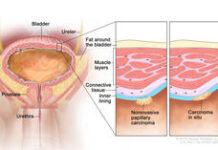In a multicentre, randomised study involving 700 women with early-stage, low-risk cervical cancer, simple hysterectomy was noninferior to radical hysterectomy with respect to pelvic recurrence at 3 years. Simple hysterectomy was also associated with fewer urologic complications.
The findings from the SHAPE (Simple Hysterectomy and Pelvic Node Assessment) study are published by Dr. Marie Plante of L’Hôtel-Dieu de Québec in Quebec City, Canada and colleagues in the 29th February 2024 issue of The New England Journal of Medicine.
The authors wrote in the background that retrospective data suggest that the incidence of parametrial infiltration is low in patients with early-stage low-risk cervical cancer, which raises questions regarding the need for radical hysterectomy in these patients. However, data from large, randomised studies comparing outcomes of radical and simple hysterectomy are lacking. The authors designed the SHAPE study to evaluate the safety of simple hysterectomy as compared with radical hysterectomy in patients with low-risk early-stage cervical cancer.
They conducted a multicentre, randomised, noninferiority study comparing radical hysterectomy with simple hysterectomy including lymph-node assessment in patients with low-risk cervical cancer (lesions of ≤2 cm with limited stromal invasion). The primary outcome was cancer recurrence in the pelvic area (pelvic recurrence) at 3 years. The prespecified noninferiority margin for the between-group difference in pelvic recurrence at 3 years was 4 percentage points.
Among 700 patients who underwent randomisation (350 in each group), the majority had tumours that were stage IB1 according to the 2009 FIGO (91.7%), that had squamous-cell histologic features (61.7%), and that were grade 1 or 2 (59.3%). With a median follow-up time of 4.5 years, the incidence of pelvic recurrence at 3 years was 2.17% in the radical hysterectomy group and 2.52% in the simple hysterectomy group with an absolute difference of 0.35 percentage points (90% confidence interval −1.62 to 2.32). Results were similar in a per-protocol analysis.
The incidence of urinary incontinence was lower in the simple hysterectomy group than in the radical hysterectomy group within 4 weeks after surgery (2.4% versus 5.5%; p = 0.048) and beyond 4 weeks (4.7% versus 11.0%; p = 0.003). The incidence of urinary retention in the simple hysterectomy group was also lower than that in the radical hysterectomy group within 4 weeks after surgery (0.6% versus 11.0%; p < 0.001) and beyond 4 weeks (0.6% versus 9.9%; p < 0.001).
The authors commented that limitations of the study include the small number of events in terms of disease recurrence or death that occurred during the follow-up period, which resulted in wide confidence intervals around hazard ratios for time-to-event outcomes. The median follow-up time was 4.5 years and disease recurrence beyond this time frame is possible. The surgical approach (minimally invasive or open) was chosen by surgeons after randomisation and was not a stratification factor.
The authors emphasised that the results cannot be generalised to patients who do not meet the criteria for low-risk disease used in the study: lesions measuring ≤2 cm and invasion of <50% of stromal tissue or to a depth of <10 mm or both.
The study was conducted largely in Western Europe, South Korea, and Canada. Black women and Native Americans were underrepresented, and therefore, results cannot be generalised to these populations or to populations in developing nations.
Reference
Plante M, Kwon JS, Ferguson S, et al. for the CX.5 SHAPE investigators. Simple versus Radical Hysterectomy in Women with Low-Risk Cervical Cancer. N Engl J Med 2024; 390:819-829.





